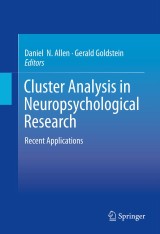Details

Cluster Analysis in Neuropsychological Research
Recent Applications|
93,08 € |
|
| Verlag: | Springer |
| Format: | |
| Veröffentl.: | 08.07.2014 |
| ISBN/EAN: | 9781461467441 |
| Sprache: | englisch |
| Anzahl Seiten: | 136 |
Dieses eBook enthält ein Wasserzeichen.
Beschreibungen
Cluster analysis is a multivariate classification technique that allows for identification of homogenous subgroups within diverse samples based on shared characteristics. In recent years, cluster analysis has been increasingly applied to psychological and neuropsychological variables to address a number of empirical questions. This book provides an overview of cluster analysis, including statistical and methodological considerations in its application to neurobehavioral variables. First, an introduction to cluster analysis is presented that emphasizes issues of relevance to neuropsychological research, including controversies surrounding it use. Cluster analysis is then applied to clinical disorders that do not have an associated prototypical neuropsychological profile, including traumatic brain injury, schizophrenia, and health problems associated with homelessness. In a second application, cluster analysis is used to investigate the course of normal memory development. Finally, cluster analysis is applied to classification of brain injury severity in children and adolescents who sustained traumatic brain injury.
Chapter 1. Introduction.- Chapter 2.Statistical and Methodological Considerations When Using Cluster Analysis in Neuropsychological Research.- Chapter 3: Application of Cluster Analysis to Investigate Neuropsychological Heterogeneity in Psychiatric and Neurological Patients.- Chapter 4. Identifying Neurodevelopmental Stages of Memory from Childhood through Adolescence with Cluster Analysis.- Chapter 5. Classification of traumatic brain injury severity: A neuropsychological approach.- Chapter 6:Concluding Remarks.
<p>Daniel N. Allen, Ph.D., is professor in the Department of Psychology at University of Nevada Las Vegas. He has published more than 125 scientific papers addressing various aspects of clinical neuropsychology and psychopathology. He has received national recognition for his work in the area of clinical neuropsychology, as evidenced by a number of prestigious awards, including the Nelson Butters Award and the Early Career Award from the National Academy of Neuropsychology. He has also received the Barrick Distinguished Scholar Award and the William Morris Award for Excellence in Scholarship from the University of Nevada Las Vegas.</p><p> Gerald Goldstein, Ph.D., is senior research career scientist at the VA Pittsburgh Healthcare System. He has received numerous honors and awards for his contributions to clinical neuropsychology, and has served the field in a variety of highly visible leadership positions, including President of the National Academy of Neuropsychology, President of the Clinical Neuropsychology Division (40) of the American Psychological Association, and President of the International Neuropsychological Society. Dr. Goldstein has authored more than 300 scientific papers.</p>
<p>Classification and subtyping have been an important part of psychology from its earliest days, essential to personality, pathology, and other key aspects of the field. Within neuropsychology specifically, improvements in classification have led to greater accuracy in assessment, diagnosis, and approaches to treatment, with cluster analysis recently emerging as a complement or an alternative to clinical observation and to other statistics-based methods.</p><p><i>Cluster Analysis in Neuropsychological Research</i> reviews the basics of cluster analysis, examines challenges to its use, and applies its methods to ongoing research questions across neuropsychology. Chapters illustrate the mathematical concepts underlying cluster analysis and overview areas of its most notable use (e.g., learning disabilities, brain injury, schizophrenia) before moving on to current lines of inquiry. Subjects in these studies include individuals with medical pathologies, neurologically stable individuals with diagnosed psychiatric illness, and normal individuals, resulting not only in useful empirical data, but also robust methods by which new studies may be developed. Included in the coverage:</p><ul><li>Statistical and methodological considerations when using cluster analysis.</li><li>Application of cluster analysis to investigate neuropsychological heterogeneity in psychiatric and neurological patients.</li><li>Identifying neurodevelopmental stages of memory from childhood through adolescence with cluster analysis.</li><li>A neuropsychological approach to classifying TBI severity in youth.</li><li>Classification with cluster analysis of health problems of homeless veterans.</li><li>Possibilities for using cluster analysis in other diverse areas of neuropsychology.</li></ul><p>Neuropsychologists and cognitive neuroscientists will find <i>Cluster Analysis in Neuropsychological Research </i>a stimulating guide to a promising platform for future developments in thefield.</p>
Provides descriptions of accessible and readily applicable classification methods relevant to neuropsychological research Provides guidance to understanding of the now extensive cluster analytic literature in neuropsychology Provides illustrations of how behaviorally based subgroups within several clinical entities can be related to various other neuroscience methods Includes supplementary material: sn.pub/extras
Diese Produkte könnten Sie auch interessieren:

Practitioner's Guide to Symptom Base Rates in the General Population

von: Robert J. McCaffrey, Lyndsey Bauer, Anjali A. Palav, Sid O'Bryant

53,49 €















